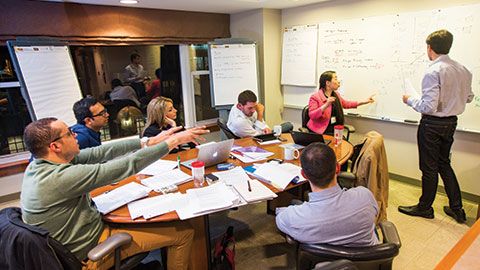Driving Organizational Agility—Virtual
- Dates: TBD
- Format: Virtual Synchronous learning at designated live online session times.
- Fee: TBD
The program fee covers tuition, e-books, and online case materials.
This program includes live online classes, self-paced work, discussion groups, and virtual networking.
"Bringing together people from different walks of life, industries, and countries across the globe was amazing."

"The program connects learning concepts to real-world cases so you get the best of both worlds."
Summary
Today's businesses must be alert to changes in the external environment, develop competitive strategies quickly—and adapt the organization to execute. In this virtual program, you'll explore organizational structures and processes that have enabled businesses to change direction quickly and manage successful execution of ever-shifting strategies. You will also learn how to embed agility into your organization's DNA as you shape your strategy, your organization, and your people. Acquiring a deeper understanding of the role of leaders in mobilizing and driving change, you will emerge ready to propel higher levels of responsiveness throughout your organization.
This program is eligible for the Digital Transformation Certificate. Learn More
-
Summary
-
Today's businesses must be alert to changes in the external environment, develop competitive strategies quickly—and adapt the organization to execute. In this virtual program, you'll explore organizational structures and processes that have enabled businesses to change direction quickly and manage successful execution of ever-shifting strategies. You will also learn how to embed agility into your organization's DNA as you shape your strategy, your organization, and your people. Acquiring a deeper understanding of the role of leaders in mobilizing and driving change, you will emerge ready to propel higher levels of responsiveness throughout your organization.

This program is eligible for the Digital Transformation Certificate. Learn More
DetailsExpand AllCollapse All
Design your organization to facilitate core elements of agilityDesign your organization to facilitate core elements of agility
- Achieve organizational alignment while providing sufficient autonomy
- Foster innovation by experimentation, iteration, and quick adaptation
- Empower teams to move quickly by breaking down silos and organizational barriers
- Evolve customer-centric structures and processes
Drive organizational transformation for greater agilityDrive organizational transformation for greater agility
- Shift from traditional to more flexible management processes and structures
- Measure and manage performance in ways that create alignment and accountability
- Grow your business and scale your organization while sustaining agility
- Develop internal governance to drive flexibility
Expand your personal and professional networkExpand your personal and professional network
- Extend your network by connecting and working with accomplished executives from various backgrounds, industries, and countries around the globe
- Build relationships with a diverse group of peers who can provide wide-ranging insights into your business challenges and career decisions
Design your organization to facilitate core elements of agility
- Achieve organizational alignment while providing sufficient autonomy
- Foster innovation by experimentation, iteration, and quick adaptation
- Empower teams to move quickly by breaking down silos and organizational barriers
- Evolve customer-centric structures and processes
Drive organizational transformation for greater agility
- Shift from traditional to more flexible management processes and structures
- Measure and manage performance in ways that create alignment and accountability
- Grow your business and scale your organization while sustaining agility
- Develop internal governance to drive flexibility
Expand your personal and professional network
- Extend your network by connecting and working with accomplished executives from various backgrounds, industries, and countries around the globe
- Build relationships with a diverse group of peers who can provide wide-ranging insights into your business challenges and career decisions
Who Should Attend
- C-level decision-makers, heads of business units or regional organizations, and anyone responsible for the P&L of an organization
- Leaders within business functions such as R&D, finance, engineering, and human resources, including chief people officers
- Leaders and members of cross-functional teams implementing strategy, as well as consultants
Attendance by multiple company representatives will foster teamwork and amplify the program's impact on your organization.
- C-level decision-makers, heads of business units or regional organizations, and anyone responsible for the P&L of an organization
- Leaders within business functions such as R&D, finance, engineering, and human resources, including chief people officers
- Leaders and members of cross-functional teams implementing strategy, as well as consultants
Attendance by multiple company representatives will foster teamwork and amplify the program's impact on your organization.
Leaders in Virtual Learning
When you participate in a virtual HBS Executive Education program, you benefit from a powerful learning experience carefully designed with a virtual setting in mind. Through live, synchronous program sessions you'll engage directly with our renowned faculty to learn from their latest research, gain actionable takeaways, and facilitate your growth. In addition, virtual discussion groups will connect you to a global group of peers and build your network.
-
Leaders in Virtual Learning
-
When you participate in a virtual HBS Executive Education program, you benefit from a powerful learning experience carefully designed with a virtual setting in mind. Through live, synchronous program sessions you'll engage directly with our renowned faculty to learn from their latest research, gain actionable takeaways, and facilitate your growth. In addition, virtual discussion groups will connect you to a global group of peers and build your network.
Admissions Criteria and Process
Answering Your Questions
Application Submission
Application Review
Fee, Payment, and Cancellations
Answering Your Questions
Application Submission
Application Review
Fee, Payment, and Cancellations
What You Will Learn
Through faculty presentations, case studies, interactive exercises, small-group discussions, and guest speakers including some case protagonists, you will explore the importance of organizational agility and how to implement structures and processes that create a more agile organization over the short and long term. As you become conversant with the frameworks, tools, and terminology of agile methods, you will be better able to strike the right balance between managing day-to-day business and remaining responsive to change and opportunity.
-
What You Will Learn
-
Through faculty presentations, case studies, interactive exercises, small-group discussions, and guest speakers including some case protagonists, you will explore the importance of organizational agility and how to implement structures and processes that create a more agile organization over the short and long term. As you become conversant with the frameworks, tools, and terminology of agile methods, you will be better able to strike the right balance between managing day-to-day business and remaining responsive to change and opportunity.
Program Format
The program takes place over three weeks, with live, synchronous classes every Tuesday and Thursday (between 9:00 AM and 3:00 PM ET, including a 15-minute break and a 30-minute break), and small group discussions for learning and networking in the early mornings. Class sessions will take place via the Zoom platform. You will also have ample opportunity for interaction with faculty and peers inside and outside the class sessions.
Collaborative learning is an integral part of the experience. To maximize the benefit for everyone, you are expected to attend every session, complete all assignments, and contribute effectively in the class and in small groups. We advise setting aside a total of 3-5 hours per week for case preparation in addition to the synchronous class sessions.
Participants should expect to spend at least 9-12 hours on self-paced case preparation prior to attending the program. Case materials will be made available approximately two weeks prior to program start.
-
Program Format
-
The program takes place over three weeks, with live, synchronous classes every Tuesday and Thursday (between 9:00 AM and 3:00 PM ET, including a 15-minute break and a 30-minute break), and small group discussions for learning and networking in the early mornings. Class sessions will take place via the Zoom platform. You will also have ample opportunity for interaction with faculty and peers inside and outside the class sessions.
Collaborative learning is an integral part of the experience. To maximize the benefit for everyone, you are expected to attend every session, complete all assignments, and contribute effectively in the class and in small groups. We advise setting aside a total of 3-5 hours per week for case preparation in addition to the synchronous class sessions.
Participants should expect to spend at least 9-12 hours on self-paced case preparation prior to attending the program. Case materials will be made available approximately two weeks prior to program start.
Key TopicsExpand AllCollapse All
Understanding the agility imperativeUnderstanding the agility imperative
- Recognizing the demand for agility
- Examining the relationship between agility and ability to scale
- Moving from strategic imperative to organizational responses
Creating an agile governance modelCreating an agile governance model
- Finding the right measures to drive agility
- Employing Objectives and Key Results (OKR) as a performance management tool
- Using performance data to drive results
- Implementing governance structures for flexible resource allocation
- Evolving more agile risk management
Implementing agilityImplementing agility
- Applying agile elements: roles, ceremonies, and artifacts in the Scrum framework
- Creating an agile workforce
- Exploring "hacks" for quickly implementing agility best practices
- Providing space for experimentation (including digital experimentation), creativity, and iterative problem solving
- Bringing agility to entrepreneurial initiatives within your company
- Incorporating design thinking into an agile mindset
- Enabling an outside-in innovation approach that leverages deep customer insight
Teaming for agilityTeaming for agility
- Leading agile teams
- Establishing team norms, goals, and processes
- Creating effective cross-functional teams
- Creating psychological safety and helping team members feel comfortable with change
Organizing for agilityOrganizing for agility
- Establishing "freedom within a framework"
- Shifting from a rules-based to a principles-based organizational culture
- Fostering transparency and trust
- Removing organizational barriers and silos
- Applying a design perspective to internal processes and systems
Understanding the agility imperative
- Recognizing the demand for agility
- Examining the relationship between agility and ability to scale
- Moving from strategic imperative to organizational responses
Creating an agile governance model
- Finding the right measures to drive agility
- Employing Objectives and Key Results (OKR) as a performance management tool
- Using performance data to drive results
- Implementing governance structures for flexible resource allocation
- Evolving more agile risk management
Implementing agility
- Applying agile elements: roles, ceremonies, and artifacts in the Scrum framework
- Creating an agile workforce
- Exploring "hacks" for quickly implementing agility best practices
- Providing space for experimentation (including digital experimentation), creativity, and iterative problem solving
- Bringing agility to entrepreneurial initiatives within your company
- Incorporating design thinking into an agile mindset
- Enabling an outside-in innovation approach that leverages deep customer insight
Teaming for agility
- Leading agile teams
- Establishing team norms, goals, and processes
- Creating effective cross-functional teams
- Creating psychological safety and helping team members feel comfortable with change
Organizing for agility
- Establishing "freedom within a framework"
- Shifting from a rules-based to a principles-based organizational culture
- Fostering transparency and trust
- Removing organizational barriers and silos
- Applying a design perspective to internal processes and systems
The HBS Advantage
Our Executive Education programs are developed and taught by HBS faculty who are widely recognized as skilled educators, groundbreaking researchers, and award-winning authors. Through their board memberships, consulting, and field-based research, they address the complex challenges facing business leaders across the globe.
Paul R. Lawrence MBA Class of 1942 Professor of Business Administration
Philip J. Stomberg Professor of Business Administration
Novartis Professor of Leadership and Management
Eliot I. Snider and Family Baker Foundation Professor and Professor of Business Administration, Emeritus
George F. Baker, Jr. Professor of Public Management
William Barclay Harding Professor of Business Administration
-
The HBS Advantage
-
Our Executive Education programs are developed and taught by HBS faculty who are widely recognized as skilled educators, groundbreaking researchers, and award-winning authors. Through their board memberships, consulting, and field-based research, they address the complex challenges facing business leaders across the globe.
Faculty CochairsPaul R. Lawrence MBA Class of 1942 Professor of Business Administration
HBS Units:Organizational BehaviorEntrepreneurial ManagementPhilip J. Stomberg Professor of Business Administration
HBS Unit:Accounting and ManagementFacultyNovartis Professor of Leadership and Management
HBS Unit:Technology and Operations ManagementHarvard Business School:Eliot I. Snider and Family Baker Foundation Professor and Professor of Business Administration, Emeritus
Harvard Kennedy School:George F. Baker, Jr. Professor of Public Management
HBS Unit:General ManagementWilliam Barclay Harding Professor of Business Administration
HBS Unit:Technology and Operations Management
Your Peers Expand Your Learning
-
Your Peers Expand Your Learning
-
Global PerspectiveExperience the world in your classroom.Global PerspectiveExperience the world in your classroom.6%Africa22%Europe11%Latin America9%Middle East42%North America6%Africa22%Europe11%Latin America9%Middle East42%North AmericaTop Industries RepresentedInsights from a range of industries ignite your thinking.Insights from a range of industries ignite your thinking.15%Financial14%High Technology13%Professional Services12%Consumer Products11%Health Care6%Chem / Pharma / Bio6%Raw Materials / Energy3%Education3%Utilities / Telecom2%Nonprofit ServicesTop Industries RepresentedInsights from a range of industries ignite your thinking.15%Financial14%High Technology13%Professional Services12%Consumer Products11%Health Care6%Chem / Pharma / Bio6%Raw Materials / Energy3%Education3%Utilities / Telecom2%Nonprofit ServicesExperienceExperienceYears workedYears workedExperienceYears workedLess than 10 yearsLess than 10 years10-14 years10-14 years15-19 years15-19 years20-24 years20-24 years25-29 years25-29 years30-34 years30-34 years35-39 years35-39 years40 or more40 or moreLess than 10 yearsLess than 10 years10-14 years10-14 years15-19 years15-19 years20-24 years20-24 years25-29 years25-29 years30-34 years30-34 years35-39 years35-39 years40 or more40 or more

"Bringing together people from different walks of life, industries, and countries across the globe was amazing."




















